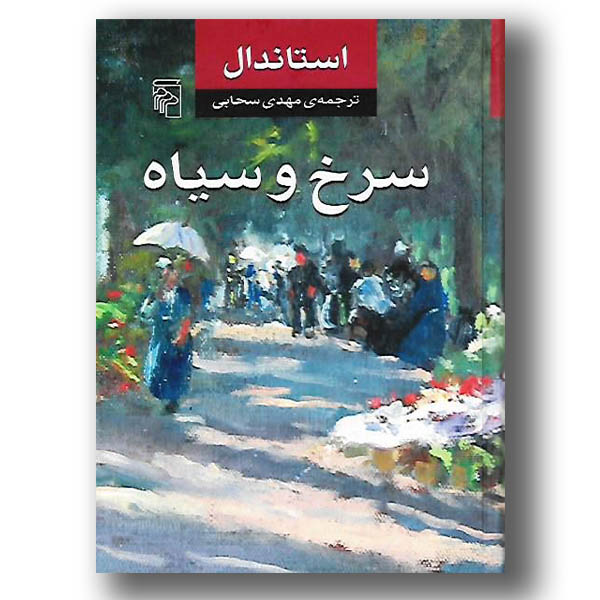در روزهای قطع دسترسی به اینترنت بینالملل، همزمان با تجاوز رژیم صهیونیستی، به سراغ مجلات قدیمی چاپی رفتم. در میان آنها مقالهای توجهم را جلب کرد که بهجای تیتر مرسوم، این تقدیمنامه را داشت:
«به اندک کسانی که از خواندن آثار استاندال لذت میبرند».
نویسنده بهطور پوشیده به این اشاره کرده بود که استاندال در واقع یک جاسوس انگلیسی بوده است و این را چنین بیان میکرد:
«در گذشته چندان دشوار نبود که جاسوس را از غیرجاسوس تشخیص دهی؛ کافی بود یک انگلیسی استاد ادبیات فرانسه باشد. او که از ناپلئون سخن میگفت، خواهری داشت به نام پائولین!»

سپس به معرفی قرمز و سیاه (Le Rouge et le Noir) پرداخت؛ رمانی فرانسویـایتالیایی که نشان میداد استاندال تا چه اندازه شیفته ایتالیا بود، بهویژه دره پو و دریاچههای کوهستانی آن. این علاقه، برخاسته از موقعیت راهبردی و فرهنگی این نواحی بود که آبراهها و گذرگاههای حیاتی را در دل خود داشتند؛ همان چیزی که قدرتهای استعماری برای انتقال نیرو، اطلاعات و نفوذ فرهنگی روی آن حساب میکردند — درست مانند رودخانهها و دریاهای ایران که از دیرباز شریان تمدنی و نقطه تسلط بر تجارت و سیاست به شمار میآمدند.
در میانه مقاله، جملهای برجسته بود که رنگوبوی امروز را نیز دارد:
«این را بدان که اگر همچنان با حسن نیت بمانی، ما باهم به توافق خواهیم رسید.»
حتی امروز، در اوج درگیری و جنگ، پژواک همین جمله را میشنویم. آمریکا روز مشخصی را برای مذاکره تعیین کرده بود، در حالیکه همانزمان جاسوسها و فناوریهای ارتباطیشان مختصات دقیق بمبارانها را منتقل میکردند. گویی همان خط مذاکره مدیریتشده که استاندال از آن سخن گفته بود، سالها بعد هم الهامبخش روشهای فشار و چانهزنی باقی مانده است. چنانکه نماینده دائم ایران در سازمان ملل، برای نشان دادن حسن نیت، بدون اطلاعرسانی رسمی در رسانههای داخلی، مصاحبهای انجام داد و اعلام کرد ۴۰۰ کیلوگرم از اورانیوم غنیسازیشده ایران از کشور خارج شده است.
آمریکا هم در حالی بهدنبال زمان اعلام رسمی مذاکره بود که پاسخ نظامی ایران به تجاوز اسرائیل متوقف شده بود و اسرائیل همچنان به نقض آتشبس ادامه میداد. نتیجه آنکه امروز آنچه رژیم صهیونیستی و آمریکا از کشتار جمعی مردم بیگناه در جنگ دوازدهروزه ـ و پیش از آن ـ برداشت میکنند، محصول همان نفوذ تاریخی است که بذرش سالها پیش در مسیر رودخانهها و دریاهای ایران کاشته شد؛ آبراههایی که همواره نهتنها منبع حیات، بلکه بستر سلطه اطلاعاتی و فرهنگی قدرتهای بیگانه بودهاند.
بهاینترتیب میتوان دریافت که الگوی نفوذ در گذرگاههای آبی، همچنان از گذشته تا امروز، بهمثابه ابزاری برای تحمیل اراده سیاسی و نظامی بر ملتها بهکار میرود — الگویی که هنوز هم تکرار میشود.
_________________
In the days of the international Internet blackout, at the same time as the Zionist regime’s aggression, I went to old printed magazines. Among them, an article caught my attention, which, instead of the usual headline, had this dedication:
“To the few who enjoy reading Stendhal’s works.”
The author had hinted covertly that Stendhal had actually been an English spy, stating this as follows:
“In the past, it was not so difficult to distinguish a spy from a non-spy; it was enough for an Englishman to be a professor of French literature. He, who spoke of Napoleon, had a sister named Paolean!”
He then introduced Le Rouge et le Noir (The Red and the Black), a Franco-Italian novel that showed how much Stendhal was fascinated by Italy, especially the Po Valley and its mountain lakes. This interest arose from the strategic and cultural location of these areas, which had vital waterways and passages in their heart; The very thing that colonial powers counted on for the transfer of power, information, and cultural influence—just as the rivers and seas of Iran had long been the arteries of civilization and the point of control over trade and politics.
In the middle of the article, there was a striking sentence that still has its resonance today:
“Know this, if you remain in good faith, we will come to an agreement together.”
Even today, at the height of conflict and war, we hear the echoes of this sentence. The United States had set a specific day for negotiations, while at the same time its spies and communications technologies were transmitting the precise coordinates of the bombings. It is as if the same managed line of negotiation that Stendhal spoke of continues to inspire methods of pressure and bargaining years later. As a sign of goodwill, Iran’s permanent representative to the United Nations gave an interview to the domestic media without officially informing them and announced that 400 kilograms of Iran’s enriched uranium had left the country.
The United States was also looking for a time to officially announce negotiations while Iran’s military response to Israel’s aggression had stopped and Israel continued to violate the ceasefire. The result is that what the Zionist regime and the United States are reaping today from the mass killing of innocent people in the Twelve-Day War – and before that – is the product of the same historical influence whose seeds were sown years ago in the course of Iran’s rivers and seas; waterways that have always been not only a source of life, but also a platform for the informational and cultural domination of foreign powers.
Thus, it can be seen that the pattern of influence over waterways has continued to be used as a tool to impose political and military will on nations from the past to the present—a pattern that is still repeated.